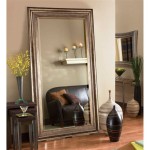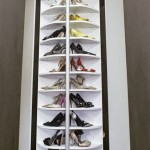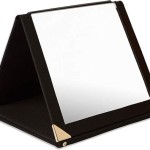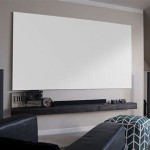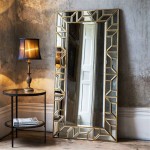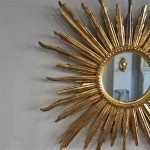Mirrors in History
Mirrors, seemingly ubiquitous in modern life, possess a rich and complex history intertwined with technological advancement, cultural significance, and evolving perceptions of self. From rudimentary reflective surfaces in nature to the precision-engineered glass mirrors of today, their development reflects humanity's enduring fascination with reflection and its implications.
The earliest forms of mirrors were far removed from the clarity of modern glass. Still pools of water provided primitive reflections, offering glimpses of one's image distorted by ripples and imperfections. Such natural "mirrors" likely served a practical purpose, allowing early humans to observe animals approaching a water source or to check their own appearance for injuries or parasites. These rudimentary reflections marked the beginning of a long journey towards understanding and manipulating reflection.
As civilizations developed, so too did the technology of mirror-making. Polished obsidian, a naturally occurring volcanic glass, became a popular choice for creating reflective surfaces. Examples of obsidian mirrors have been found in Anatolia dating back to around 6000 BCE. These early manufactured mirrors, though still far from perfect, represented a significant step forward. They provided a more controlled and consistent reflection than water, demonstrating a growing desire for a clearer understanding of one's own image.
In ancient Egypt, polished metal, particularly copper and bronze, became the material of choice for mirror production. These metal mirrors, often elaborately decorated and incorporated into handheld implements or furniture, served both practical and symbolic purposes. They became associated with the sun god Ra, reflecting his light and power. The Egyptians believed that mirrors held magical properties and were often included in burial goods to assist the deceased in the afterlife.
The development of glassmaking opened a new chapter in the history of mirrors. Early glass mirrors, produced by the Romans around the 1st century CE, involved backing a piece of glass with molten lead or tin. This technique, while relatively crude, produced a more reflective surface than polished metal. However, these early glass mirrors were often small and expensive, limiting their availability to the wealthy elite.
The transition to more sophisticated glass mirrors occurred during the late Middle Ages and the Renaissance. Venetian glassmakers perfected a technique of coating glass with a thin layer of silver amalgam, resulting in mirrors of superior clarity and reflectivity. Venice became a center of mirror production, and Venetian mirrors were highly prized throughout Europe. The intricate designs and craftsmanship of these mirrors elevated them to works of art, reflecting the growing wealth and artistic sensibilities of the Renaissance period.
The 17th and 18th centuries saw continued advancements in mirror-making technology. The invention of the process for casting large plates of glass allowed for the production of larger and more affordable mirrors. This development coincided with the rising popularity of elaborate interior design styles like Baroque and Rococo, where large mirrors played a central role in creating illusions of space and grandeur. Mirrors became essential elements in palaces and grand homes, reflecting both the opulence of the era and the evolving societal values.
The Industrial Revolution further democratized access to mirrors. Mass production techniques made mirrors significantly cheaper, transforming them from luxury items to everyday objects. Technological innovations, such as the development of silvering techniques using chemical deposition, led to the production of even clearer and more durable mirrors. This widespread availability of mirrors had a profound impact on society, influencing fashion, personal grooming, and the very notion of self-image.
The 20th and 21st centuries have witnessed the continued evolution of mirror technology. Developments in glass manufacturing and coating techniques have led to the production of highly specialized mirrors for scientific and technological applications. Telescopes, lasers, and medical imaging devices all rely on the precise reflective properties of mirrors. These advancements demonstrate the enduring importance of mirrors, not only as everyday objects but also as crucial components in scientific exploration and technological progress.
From their humble beginnings as reflections in still water to their complex role in modern technology, mirrors have played a significant role in human history. Their evolution reflects not only advancements in material science and manufacturing techniques but also changing cultural values and perceptions of self. The story of the mirror continues to unfold as new technologies and applications are developed, ensuring that this reflective surface remains a vital part of human experience.
Furthermore, the cultural significance of mirrors cannot be overlooked. Across different cultures and time periods, mirrors have been imbued with symbolic meanings. They have been associated with vanity, truth, self-knowledge, and even magic. In some cultures, mirrors are believed to be portals to other worlds or to hold the souls of the deceased. These diverse interpretations highlight the complex and multifaceted relationship between humans and their reflections.
The history of mirrors also reflects the development of human self-awareness. The ability to see oneself objectively, facilitated by increasingly accurate reflective surfaces, has undoubtedly shaped our understanding of identity and individuality. Mirrors have allowed us to examine ourselves, both physically and metaphorically, prompting reflection on our appearance, emotions, and place in the world.

The History Of Mirror Through A Glass Darkly Bienenstock Furniture Library

History Of The Mirrors Paris

The Rise Of Mirror As Commonplace

History Of Mirrors Homes Direct 365 Blog

Mirror Wikipedia

The History Of Mirror And Its Evolving Style Through Ages

Mirror History Invention Of The Mirrors And Its Origins

The History Of Mirror Through A Glass Darkly Bienenstock Furniture Library

Cabinet A Short History Of The Glass Mirror

Broe Mirror Wikipedia

